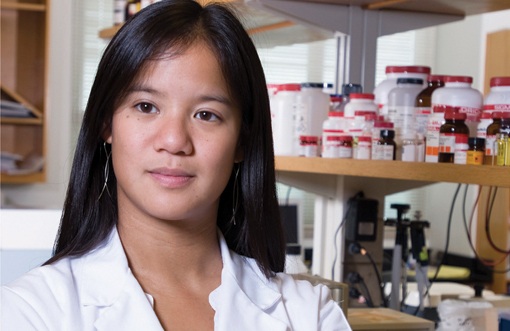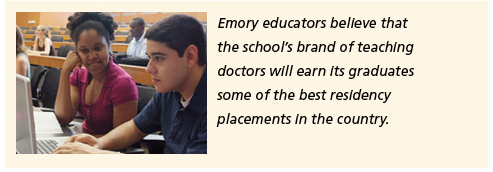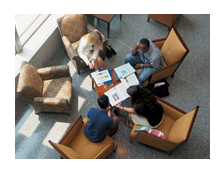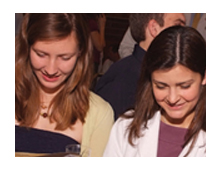Education: The year of the curriculum

After years of planning and implementation, it finally arrived — the year of the curriculum. In fall 2007, entering Emory medical students were the first to be immersed in a dramatically revamped curriculum designed to shape them into physicians and leaders ready to meet the changing, challenging needs and opportunities of the 21st century.
Students in the class of 2011 are working as hard as those in earlier classes who followed the traditional first-year curriculum of intense basic science lectures. But there are three big differences.
Second is that the new students begin acquiring clinical experience and skills almost from day 1, not only in realistic simulations with patient actors and robots but also in a biweekly outpatient clinic session where they work one-on-one with a mentor physician. No more lockstep progression through basic science lectures for two years before clinical rotations begin. The basic science is still there, but the new curriculum artfully weaves it with real-life patient applications.

The third striking difference is that students in the class of 2011 are jazzed about what they are doing and learning. Based on what practicing doctors and medical students everywhere had told them, they had expected to be tired and miserable during their first year of medical school. Instead, in the words of one student, they find themselves understandably tired but also "ridiculously happy." Even the hardest work—and there is plenty of it—is infused with purpose. Interactions with patients send students to classes, the anatomy laboratory, the library, and Internet-available teaching materials, with enhanced determination to learn what they need as physicians. Increased faculty interactions, individually and in an extensive society mentoring program, encourage them to raise questions and model behaviors that will make them compassionate, curious, and committed physicians and leaders in their communities.

The building that makes it possible Last year was also the year of the new building, the medical school's new home, designed to accommodate the new curriculum and to maximize students’ interaction with faculty, students in other health sciences professions, and each other.
Filled with life, light, and history, the building joins the architecture and soul of flanking anatomy and physiology buildings constructed in 1915. It is the first building on campus to bear the school's name and is a beacon to students that Emory has never been more committed to medical education nor more determined to be a model for training physicians.
The building made possible an immediate 15% increase in class size, with another such increase anticipated in the next decade to help alleviate a projected U.S. physician shortage.
The building also makes the curriculum go, with spaces designed for small-group learning, wireless technology, state-of-the-art computer-teaching labs open around the clock, anatomy space believed to be the finest in any medical school anywhere, and simulation space designed to immerse students in situations calling for speed, accuracy, teamwork, and sensitivity to patients and families.

If it’s not broken. . . Emory medical students have come from among the most highly-ranked, competitive college graduates in the nation, routinely scoring in the top 5% of the MCAT. Once here, they have always done well by all the usual measures. In 2007, for example, the pass rate for first-time takers of part 1 of the National Board Exam was 99%, a figure consistent with previous years. The vast majority of each year’s graduates receive their top choices for residency training.
With such good results, why did the medical school want to change the curriculum in the first place?
With research breakthroughs making their way to patients' bedsides ever more expediently, medical students must absorb more, more quickly—and become lifelong learners, at ease with change. They must have knowledge that equips them to provide revolutionary health care. And they need a firm grounding in the social sciences and humanities and in working in multidisciplinary, patient-centered teams.
First-year students love the new curriculum, but they admit to concern that its nontraditional approach takes them to board exams after only a year and a half of schooling, spent largely in learning the basic sciences not in isolation but as they apply to clinical situations.
Will that mean they perform less well on the boards than generations of their predecessors? Possibly. But the medical school's philosophy with the new curriculum is that preparing good doctors is more important than teaching to the boards. Emory educators believe that their students will do better than well enough and that Emory's brand of teaching doctors in the end also will earn its graduates some of the best residency placements in the country.
Curriculum and building are critical, but teaching is what makes good doctors. The way students are educated and treated will affect how they take care of patients and interact with others throughout their lives. Teaching is where Emory most excels, as it has done throughout its history. If the building was designed for the students, the faculty are its heroes, the ones who are using the facility to move their new curriculum forward and to make their students all that they can and should be.
